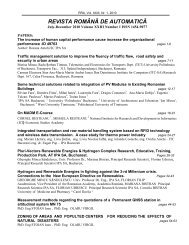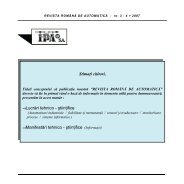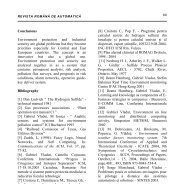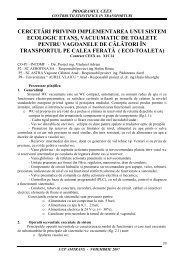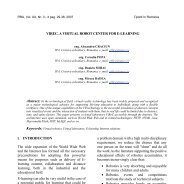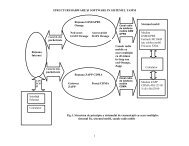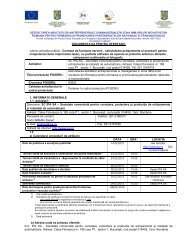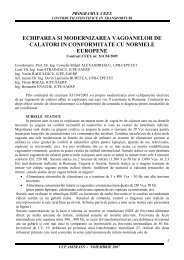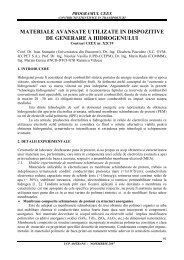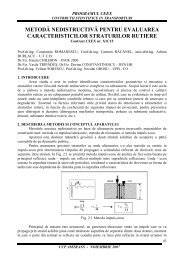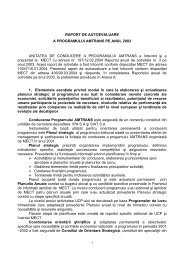REVISTA ROMÃNÄ DE AUTOMATICÄ - IPA SA
REVISTA ROMÃNÄ DE AUTOMATICÄ - IPA SA
REVISTA ROMÃNÄ DE AUTOMATICÄ - IPA SA
Create successful ePaper yourself
Turn your PDF publications into a flip-book with our unique Google optimized e-Paper software.
<strong>REVISTA</strong> ROMÂNĂ <strong>DE</strong> AUTOMATICĂ<br />
25<br />
ω4<br />
− ω1<br />
z ω3<br />
− ω<br />
= − ;<br />
ω − ω z ω − ω<br />
2<br />
1<br />
2<br />
'<br />
4<br />
4<br />
1<br />
1<br />
"<br />
4<br />
z<br />
= −<br />
z<br />
3<br />
.<br />
(3)<br />
from which, with the notations (1) he or she<br />
deduced the equalities:<br />
ω 3 = ω1<br />
( 1−<br />
i) + ω2i<br />
; ω 4 = ω1( 1+<br />
i1<br />
) + ω2i1<br />
. (4)<br />
The kinetic energy of the system:<br />
1 2<br />
2 2 2 2 2<br />
E C = ( J1ω1<br />
+ m4R<br />
ω1<br />
+ J2ω2<br />
+ J3ω3<br />
+ J4ω4)<br />
. (5)<br />
2<br />
with the notations (4) and (2) has the<br />
equation:<br />
2<br />
2<br />
( Aθ&<br />
− Bθ&<br />
θ&<br />
+ Cθ<br />
)<br />
1<br />
E = 1 2 &<br />
C 1 2 2 . (6)<br />
2<br />
The mechanic power at a certain time is given<br />
by:<br />
P = M<br />
M , (7)<br />
1ω1<br />
+ M 2ω2<br />
+ 3ω3<br />
or on the basis of the other relation (4)<br />
[ M1 + M 3( 1−<br />
i)<br />
] ω1<br />
+ ( M 2 + M3<br />
) ω2<br />
P = i<br />
(8)<br />
and from here are deduced the generalized<br />
equations:<br />
Q1 = M1<br />
+ M3 (1 − i)<br />
; Q2 = M 2 + M3i<br />
. (9)<br />
Lagrange equations. Knowing the fact that<br />
ω 1 = θ & 1 ; ω 2 = θ& 2 , (10)<br />
3. THE MOVEMENTS STUDY<br />
Permanent movement. The permanent<br />
movement is deduced from the conditions<br />
ω 1 = 0;<br />
2 = 0<br />
ω , (13)<br />
that leads to these equations<br />
[ 1 + M3( 1−<br />
i)<br />
] C + ( M 2 + M3i)<br />
B = 0<br />
[ + M 1−<br />
i)<br />
] B + ( M + M i)<br />
A 0<br />
M ;<br />
M (14)<br />
1 3( 2 3 =<br />
and since AC − B 2 > 0 , we obtained the<br />
equations<br />
M + M − i)<br />
0 ; M + M i 0 . (15)<br />
1 3 (1 =<br />
2 3 =<br />
The sources of power are present by the<br />
characteristics movement-angularly speed<br />
through the relations Mi = M i ( ωi<br />
) and goes to<br />
* * *<br />
the values: ω 1 , ω 2 , ω 3 of the angularly<br />
velocities that are obtained the permanent<br />
condition that are deduced from the equation<br />
system:<br />
*<br />
*<br />
*<br />
*<br />
M ( ω ) + (1 − i)<br />
M ( ω ) 0 ; M ( ω ) + i M ( ω ) 0 ;<br />
ω<br />
1 1<br />
3 3 =<br />
*<br />
* *<br />
3 = ( 1−<br />
) ω1<br />
+ iω2<br />
2 2 3 3 =<br />
i . (16)<br />
If these values M ( * 2 ω 2)<br />
, M ( * 3 ω 3 ) are related to<br />
the value of the moment M ( * 1 ω 1)<br />
of the heat<br />
engine, one obtained the relations (17) with<br />
the graphic representations captured in figure<br />
2 and figure 3.<br />
M 2 ( ω ) i<br />
= −<br />
*<br />
M ( ω ) i −1<br />
1<br />
*<br />
2<br />
1<br />
;<br />
M 3 ( ω ) 1<br />
= −<br />
*<br />
M ( ω ) i −1<br />
1<br />
*<br />
3<br />
1<br />
, (17)<br />
from Lagrange equations are obtained the<br />
differential equations<br />
ω &<br />
1 − Bω&<br />
2 = M1<br />
+ M 3( 1−<br />
i);<br />
− Bω&<br />
1 + Cω&<br />
2 = M 2 + M i ,<br />
A 3<br />
or<br />
ω&<br />
1<br />
ω&<br />
2<br />
=<br />
=<br />
[ M + M ( 1−<br />
i)<br />
] C + ( M + M i)<br />
1<br />
[ M − M ( 1−<br />
i)<br />
] B + ( M + M i)<br />
1<br />
3<br />
3<br />
AC − B<br />
2<br />
AC − B<br />
2<br />
2<br />
2<br />
3<br />
3<br />
B<br />
;<br />
A<br />
.<br />
(11)<br />
(12)



